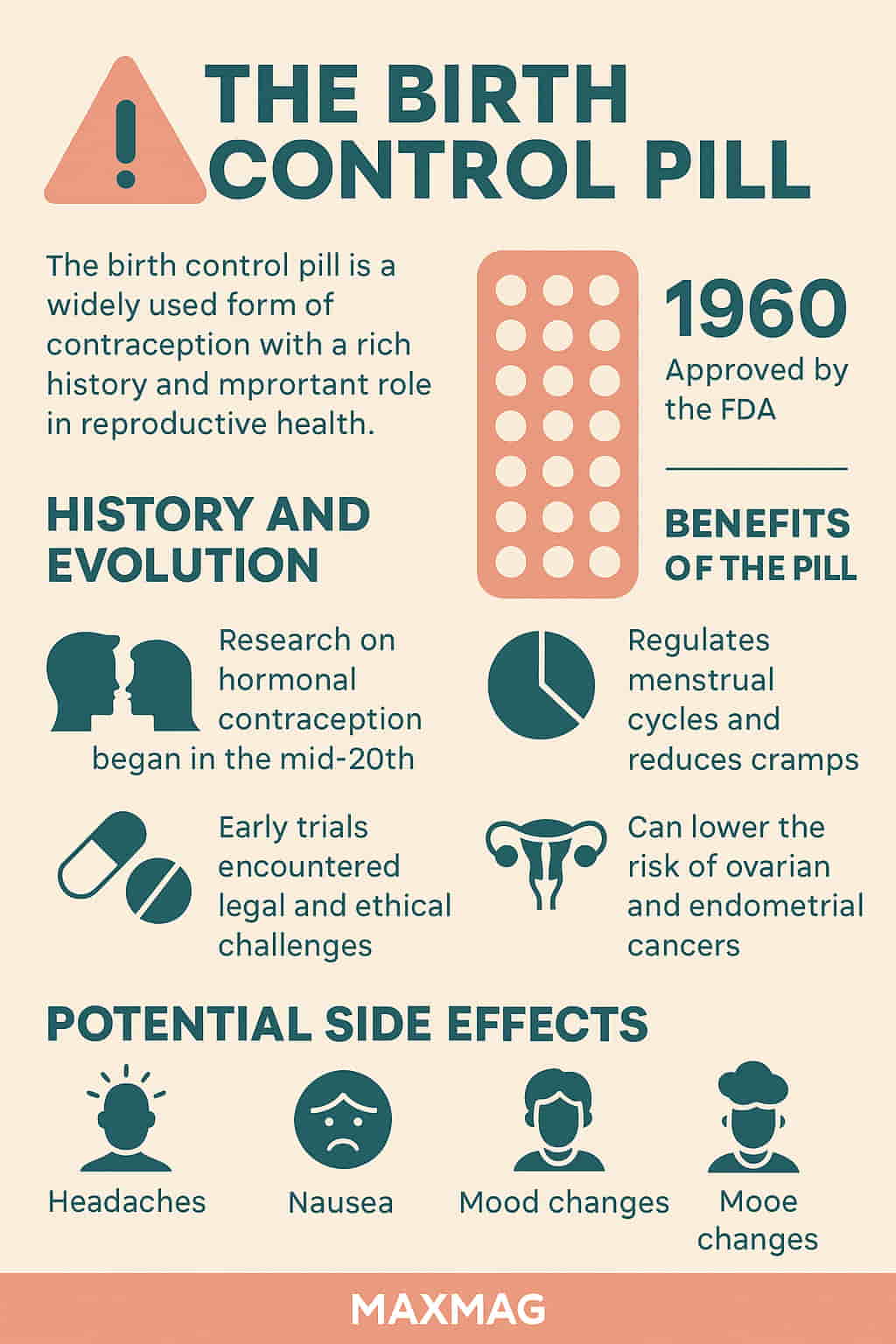
Few pharmaceutical breakthroughs have transformed human society as deeply as the oral contraceptive pill. Since its development over seven decades ago, it has not only given women control over their reproductive lives but also significantly influenced education, career opportunities, and gender dynamics.
Let’s revisit the extraordinary evolution of this small tablet—from obscure scientific experiments to its place as a cornerstone of modern medicine—and explore why the oral contraceptive pill remains so relevant today.
A Groundbreaking Start: Chemistry Meets Social Change
The 1951 Discovery That Changed Everything
The first major step toward the pill was taken in 1951, when Luis Ernesto Miramontes, a 26-year-old Mexican chemist, synthesized norethisterone, the first orally active progestin, under the supervision of American biochemist Carl Djerassi. This compound could mimic natural progesterone, inhibiting ovulation and thus preventing pregnancy.
Though Djerassi often received global recognition as “the father of the pill,” he never ceased to emphasize Miramontes’s critical role in the discovery. Their partnership laid the foundation for what would become one of the most impactful pharmaceuticals of the 20th century.
From Lab to Pharmacy: Commercial Breakthroughs
By 1960, the U.S. Food and Drug Administration approved Enovid, the first birth control pill, for contraceptive use. Within just two years, over 1.2 million American women were using it.
Soon after, Ortho-Novum hit the market, developed through a partnership between Johnson & Johnson and Syntex. Both products used synthetic hormones to manipulate the menstrual cycle and prevent pregnancy, setting a global precedent.
How the Oral Contraceptive Pill Works: Science Behind the Safety
The mechanism behind the oral contraceptive pill is multifaceted:
-
Ovulation Suppression: Prevents the release of an egg from the ovaries.
-
Cervical Mucus Thickening: Makes it harder for sperm to reach the egg.
-
Endometrial Alteration: Changes the lining of the uterus, discouraging implantation.
There are two main types of oral contraceptives:
-
Combination Pills: Contain both estrogen and progestin.
-
Progestin-Only Pills: Suitable for those who cannot take estrogen due to medical reasons.
With perfect use, these pills are over 99% effective. With typical use, their efficacy ranges from 91% to 94%, depending on user adherence (Mayo Clinic).
The Many Benefits Beyond Pregnancy Prevention
Physical and Emotional Health Improvements
Though primarily a contraceptive, the oral contraceptive pill provides a variety of additional benefits:
-
Regulates menstrual cycles, reducing cramps and PMS symptoms.
-
Improves acne, often prescribed to teens and young adults for this purpose.
-
Decreases the risk of ovarian, endometrial, and colorectal cancers.
-
Alleviates symptoms of PCOS and endometriosis, offering pain and cycle regulation.
Moreover, some users report improved mood stability and decreased anxiety due to hormonal balancing. However, this varies per individual, and reactions are not universal.
Managing Conditions Like PCOS and Endometriosis
Doctors frequently prescribe the pill for non-contraceptive uses. For example:
-
In Polycystic Ovary Syndrome (PCOS), the pill helps regulate periods and reduce androgen-related symptoms like hair growth.
-
In endometriosis, it helps control tissue growth and reduce pain by suppressing ovulation (Cleveland Clinic).
Not Without Risk: Weighing the Side Effects
While the oral contraceptive pill is generally safe, it’s not free of risks or side effects:
Common Side Effects:
-
Nausea
-
Breast tenderness
-
Headaches
-
Light spotting
-
Mood swings
These often resolve within 2–3 months as the body adjusts.
More Serious Risks:
-
Blood clots, especially in smokers over 35
-
Elevated blood pressure
-
Slightly increased risk of breast and cervical cancer, depending on use duration
Before starting the pill, women undergo screenings to ensure they’re not at risk due to conditions like:
-
History of thromboembolism
-
Uncontrolled hypertension
-
Migraines with aura
-
Smoking (especially after age 35)
It is always best to consult with a trusted physician. The American College of Obstetricians and Gynecologists offers reliable, up-to-date information on contraceptive safety.
Cultural Backlash and Political Hurdles
Religious Institutions Push Back
The oral contraceptive pill’s rise was not without controversy. Religious institutions, particularly the Catholic Church, strongly opposed its use. In 1968, Pope Paul VI issued Humanae Vitae, a papal encyclical reaffirming the Church’s disapproval of artificial birth control. This move stirred public debate, especially among women seeking reproductive independence.
Djerassi himself later reflected that the controversy may have contributed to his being overlooked for a Nobel Prize, despite his enormous scientific contributions.
The Feminist Divide
While many hailed the pill as a symbol of female empowerment, early radical feminists expressed skepticism. Some argued it enabled male sexual freedom at the expense of female health and autonomy.
Yet others saw it as revolutionary. The pill allowed women to delay childbearing, pursue education, and gain financial independence—all previously stifled by early, frequent pregnancies.
Expanding Horizons: The Pill’s Legacy in the 21st Century
A Catalyst for Female Autonomy
By separating sex from reproduction, the oral contraceptive pill empowered women to rewrite their own narratives. In countries where the pill became widely available, women enrolled in higher education in greater numbers, entered the workforce, and delayed marriage.
Economists have even linked the availability of the pill to increased female participation in corporate and political leadership roles.
Global Reach and Access Inequality
Despite its widespread use, access to the pill remains unequal. In parts of Sub-Saharan Africa and South Asia, contraceptive availability is restricted by:
-
Cultural stigma
-
Cost barriers
-
Governmental policy
-
Religious conservatism
NGOs like Population Council and Planned Parenthood Global are working to close these gaps and provide family planning access worldwide.
💊 Why the Oral Contraceptive Pill Still Matters
H2: Importance of the Oral Contraceptive Pill Today
The oral contraceptive pill remains essential—not only for birth control but for broader healthcare. In 2024 alone, over 100 million women globally used the pill either for contraception or medical reasons.
In an era of evolving gender rights and medical innovation, the pill continues to symbolize the right to choose. It’s not just a medical product; it’s a political, cultural, and emotional anchor in the lives of millions.
Frequently Asked Questions (FAQ)
1. What exactly is the oral contraceptive pill?
It’s a hormone-based tablet taken daily to prevent pregnancy. It works by inhibiting ovulation and changing the uterine environment to make fertilization unlikely.
2. How effective is the oral contraceptive pill?
Perfect use results in over 99% efficacy. Typical use, which accounts for missed doses, ranges from 91–94%.
3. Can it help with acne and hormone imbalance?
Yes. Many women see improved skin clarity and fewer hormonal swings, especially with combination pills.
4. Who should avoid taking it?
Those with blood clotting disorders, smokers over age 35, or those with certain cancers should not take it without doctor supervision.
5. Does it offer cancer protection?
Yes. Long-term use can reduce the risk of ovarian, uterine, and colorectal cancers, although breast cancer risk may slightly increase.
6. What should I do if I miss a dose?
Follow the instructions on your pill pack. Typically, you should take the missed pill as soon as possible and continue the schedule. Use backup contraception if needed.
7. Is it available over-the-counter?
Some progestin-only pills are now available OTC in the U.S., though combination pills still require a prescription.
Conclusion: A Small Pill With a Monumental Impact
The oral contraceptive pill has profoundly reshaped global societies. It has enabled millions of women to pursue careers, plan families, and live on their own terms. Despite the debates and evolving views, one truth remains: the pill remains a cornerstone of reproductive rights and gender equality.
As research evolves, new generations of contraceptives may emerge, but the legacy of this revolutionary tablet endures—scientifically, socially, and symbolically.





